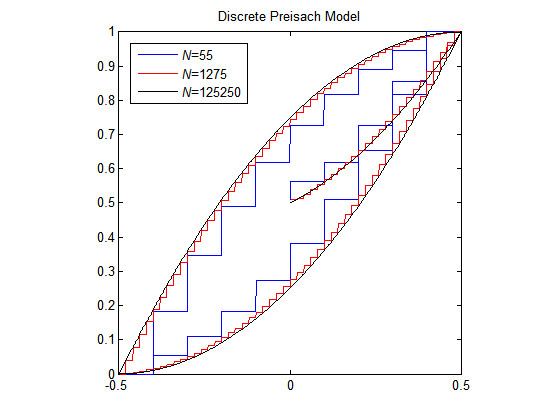 | ||
The Preisach model of hysteresis generalizes hysteresis loops as the parallel connection of independent relay hysterons. It was first suggested in 1935 by Ferenc (Franz) Preisach in the German academic journal "Zeitschrift für Physik". Since then, it has become a widely accepted model of hysteresis. The Preisach model is especially accurate in the field of ferromagnetism, as the ferromagnetic material can be described as a network of small domains, each magnetized to a value of either
Contents
Nonideal relay
The relay hysteron is the fundamental building block of the Preisach model. It is described as a two-valued operator denoted by
Above, a relay of magnitude 1.
Graphically, if
Mathematically, the output of
Where
This definition of the hysteron shows that the current value
Discrete Preisach model
The Preisach model consists of many relay hysterons connected in parallel, given weights, and summed. This is best visualized by a block diagram:
Each of these relays has different
In the limit as
The α β {\displaystyle \alpha \beta } plane
One of the easiest ways to look at the Preisach model is using a geometric interpretation. Consider a plane of coordinates
We consider only the half-plane
Next, we take a specific point on the half plane and build a right triangle by drawing two lines parallel to the axes, both from the point to the line
We now present the Preisach density function, denoted
A modified formulation of the classical Preisach model has been presented, allowing analytical expression of the Everett function. This makes the model considerably faster and especially adequate for inclusion in electromagnetic field computation or electric circuit analysis codes.
Vector Preisach Model
The vector Preisach model is constructed as the linear superposition of scalar models. For considering the uniaxial anisotropy of the material, Everett functions are expanded by Fourier coefficients. In this case, the measured and simulated curves are in a very good agreement.
